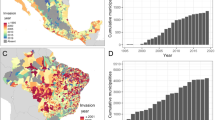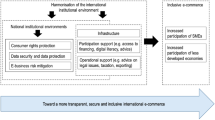Abstract
Broadband has been described as a transforming technology and is now widely available in many developed countries. However, broadband availability is not the same as broadband adoption. If the socio-economic benefits of broadband are to be realized, then adoption needs to be both understood and encouraged. This is particularly important in rural and remote areas. This paper explores the factors that drive broadband adoption in one particular rural and remote area; rural and remote Scotland. A causal model and a quantitative simulation model are developed indicating how the various drivers of adoption interact with one another. Both models show that past policy initiatives have impacted on the rate of adoption. However, the greatest impact could be achieved if future policy initiatives target those people who show no interest in adopting broadband. The paper concludes by suggesting that this work has implications for rural and remote areas all around the world.












Similar content being viewed by others
References
Andersen D and Richardson G (1997). Scripts for group model building. Syst Dynam Rev 13(2): 107–129.
Bass FM (1969). A new product growth model for consumer durables. Mngt Sci 15(5): 215–227.
Bauer JM, Kim JH and Wildman SS (2005). Effects of national policy on the diffusion of broadband in OECD countries. Paper presented at the UFL-LBS Workshop The Future of Broadband: Wired and Wireless, Gainsville, Florida, February.
Biggs P and Kelly T (2006). Broadband pricing strategies. Info 8(6): 3–14.
Brignall S (2006). Broadband and phone services going down the tube, say customers. The Guardian, 14 November, available at technology.guardian.co.uk.
Cava-Ferreruela I and Alabau-Muñoz A (2006). Broadband policy assessment: A cross-national empirical analysis. Telecommun Pol 30(8/9): 445–463.
DEFRA (2005). ICT in England's rural economies: A final report to DEFRA, available online at www.defra.gov.uk.
Fildes R and Kumar V (2002). Telecommunications demand forecasting—A review. Int J Fore 18: 489–522.
Forrester JW (1961). Industrial Dynamics. Productivity Press: Portland, OR.
Forrester JW and Senge PM (1980). Tests for building confidence in system dynamics models. In: Legasto AA Jr, Forrester JW and Lyneis JM (eds). TIMS Studies in the Management Sciences, vol. 14, North-Holland, Amsterdam.
Fransman M (2006). Global Broadband Battle—Why the US and Europe Lag While Asia Leads. Stanford Business Books: Stanford, CA.
Galloway L and Mochie R (2005). The use of ICT in rural firms: A policy-orientated literature review. Info 7(3): 33–46.
General Register Office for Scotland (2004). Household projections for Scotland: 2002-based, available online at www.gro-scotland.gov.uk.
Geroski PA (2000). Models of technology diffusion. Res Pol 29(4/5): 603–625.
Hollifield CA and Donnermeyer JF (2003). Creating demand: Influencing information technology diffusion in rural communities. Gov Inform Quart 20(2): 135–150.
Hope S, Murray L and Martin C (2004). In-Migration to the Highlands & Islands. NFO Soc Research: Edinburgh.
Hudson HE (2006). From Rural Village to Global Village. LEA: Mahwah, NJ.
ITU (2003). Birth of Broadband—ITU Internet Reports. ITU: Geneva.
ITU (2006). Trends in Telecommunication Reform 2006—Regulating in the Broadband World. ITU: Geneva.
Kim M and Kim H (2004). Innovation diffusion of telecommunications: General patterns, diffusion clusters and differences by technological attribute. Int J Innov Mngt 8(2): 223–241.
Lattemann C (2006). Public Private Partnerships im Brietbandsektor—Fallbeispiele aus den Ländern Schweden, Großbritannien, Frankreich und Deutschland. MMC Multimedia Campus, Kiel: Germany.
Lindmark S and Björstedt P (2006). The Swedish broadband market. In: Fransman M (ed). Global Broadband Battle—Why the US and Europe Lag While Asia Leads. Stanford Business Books: Stanford, California.
Lyons MH, Adjali I, Collings D and Jensen KO (2003). Complex systems models for strategic decision making. BT Technol J 21(2): 11–27.
Madden G and Simpson M (1997). Residential broadband subscription demand: An econometric analysis of Australian choice experiment data. Appl Econ 29(8): 1073–1078.
Mahajan V, Muller E and Bass FM (1990). New product diffusion models in marketing: A review and directions for research. J Marketing 54(1): 1–26.
Mahajan V, Muller E and Wind Y (2000). New-Product Diffusion Models. Kluwer Academic Publishers: Dordrecht, Netherlands.
Maier FH (1998). New product diffusion models in innovation management—A system dynamics perspective. Syst Dynam Rev 14(4): 285–308.
Milling PM (1996). Modeling innovation processes for decision support and management simulation. Syst Dynam Rev 12(3): 211–234.
National Statistics (2003). Yearbook 2003—The Official Yearbook of the United Kingdom of Great Britain and Northern Ireland. Office of National Statistics: London.
Ofcom (2004). The Ofcom Internet and Broadband Update. Ofcom: London, April.
Ofcom (2006a). The Communications Market: Nations and Regions. Ofcom: London, April.
Ofcom (2006b). The Communications Market: Nations and Regions—Scotland, Ofcom: London, April.
Ofcom (2006c). Media Literacy Audit: Report on Media Literacy Amongst People in the Nations and Regions. Ofcom: London, April.
Ofcom (2006d). The Communications Market 2006, Ofcom: London, 10 August.
Ofcom (2006e). Policy Implications Arising from the Communications Market: Nations and Regions Research. Ofcom: London, 12 October.
Oh S, Ahn J and Kim B (2003). Adoption of broadband internet in Korea: The role of experience in building attitudes. J Inform Technol 18(4): 267–280.
Osborne J (1999). Dynamic modelling to assist in the understanding of consumer take-up and the diffusion of new telecommunications services. Paper presented at the. 17th International Conference of the System Dynamics Society and 5th Australian & New Zealand Systems Conference, 20–23 July, Wellington, New Zealand.
Ovum (2006). UK broadband status summary March 2006—covering the period October 2005 to end December 2005. A Report for the Department of Trade and Industry, Ovum: London.
Parker PM (1994). Aggregate diffusion forecasting models in marketing: A critical review. Int J Forecast 10: 353–380.
Registrar General for Scotland (2005). Projected Population of Scotland (2004-based). HMSO: Edinburgh.
Roberts JH and Lattin JM (2000). Disaggregate-level diffusion model. In: Mahajan V., Muller E. and Wind Y. (eds). New-Product Diffusion Models. Springer: New York.
Robertson A, Soopramanien D and Fildes R (2004). Understanding residential Internet service adoption patterns in the UK. Teletronikk 100(4): 84–94.
Rogers EM (2003). Diffusion of Innovations, 5th ed. Free Press: New York.
Saeed K (1998). Constructing reference mode. Paper presented at the 16th International Conference of the System Dynamics Society, Quebec City.
Savage SJ and Waldman D (2005). Broadband internet access, awareness and use: Analysis of United States household data. Telecommun Pol 29: 615–633.
Scottish Enterprise (2004). Still time to plug into broadband payment, 26 January, available at www.scottish-enterprise.com.
Scottish Executive (2001a). Connecting Scotland. Scottish Executive: Edinburgh.
Scottish Executive (2001b). Digital Inclusion. Scottish Executive: Edinburgh.
Scottish Executive (2002). Making it Happen. Scottish Executive: Edinburgh.
Scottish Executive (2005). Scotland's People: Annual Report: Results from the 2003/2004 Scottish Household Survey. Scottish Executive: Edinburgh.
Sterman JD (2000). Business Dynamics: Systems Thinking and Modeling for a Complex World. Irwin/McGraw-Hill: Chicago.
Strover S (2001). Rural Internet Connectivity. Telecommun Pol 25(5): 331–347.
Teng JTC, Grover V and Guttler W (2002). Information technology innovation: General diffusion patterns and its relationships to innovation characteristics. IEEE Trans Eng Mngt 49: 13–27.
Tookey A, Whalley J and Howick S (2006). Broadband diffusion in remote and rural Scotland. Telecommun Pol 30(8/9): 481–495.
Varian H, Litan RE, Elder A and Shutter J (2002). The net impact study: The projected economic benefits of the Internet in the United States, United Kingdom, France and Germany, available online at http://www.netimpactstudy.com.
Vigden R, Francis D, Powell P and Woerndl W (2004). Web service business transformation: Collaborative commerce opportunities in SMEs. J Enterprise Inform Mngt 17(5): 372–381.
Warren M (2004). Farmers online: Drivers and impediments in adoption of Internet in UK agricultural businesses. J Small Bus Environ Develop 11(3): 371–381.
Whalley JL (2005). Local loop unbundling in the United Kingdom: Strategic reviews, institutional responses and equivalence. Paper presented at International Telecommunications Society European Regional Conference, Porto, Portugal, September.
Author information
Authors and Affiliations
Corresponding author
Rights and permissions
About this article
Cite this article
Howick, S., Whalley, J. Understanding the drivers of broadband adoption: the case of rural and remote Scotland. J Oper Res Soc 59, 1299–1311 (2008). https://doi.org/10.1057/palgrave.jors.2602486
Received:
Accepted:
Published:
Issue Date:
DOI: https://doi.org/10.1057/palgrave.jors.2602486




